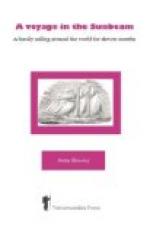Thursday, February 1st.—Careful arrangements have been made for our excursion to the Island of Inoshima, to see the great figure of Daibutz. By eight o’clock we had landed, and packed ourselves into a funny little shaky carriage, drawn by four horses. We drove quickly through the town, past the station, along the Tokaido, or imperial road, running from one end of the Island of Niphon to the other, and on which so many foreigners have been murdered even within the last ten years. Now, however, it is perfectly safe. The houses are one story high, and their walls are made of the screens I have already described. These screens were all thrown back, to admit the morning air, cold as it was. We could consequently see all that was going on within, in the sitting-room in front, and even in the bedrooms and kitchen. At the back of the house there was invariably a little garden to be seen, with a miniature rockery, a tree, and a lake; possibly also a bridge and a temple. Even in the gardens of the poorest houses an attempt at something of the sort had been made. The domestic occupations of the inhabitants being conducted in this public manner, a very good idea might be obtained, even at the end of a few miles’ drive, of how the lower class of Japanese wash and dress themselves and their children, how very elaborate the process of hair-dressing is, to say nothing of a bird’s-eye view of the ground-plan of the houses, the method of cooking food, &c.
As we emerged into the open country the landscape became very pretty, and the numerous villages, nestling in the valleys at the foot of the various small hills, had a most picturesque appearance. At a stone-quarry that we passed, on the side of a mountain, there were about seventy men at work, without any clothing, though the thermometer was far below freezing point. The Japanese are a sensitive nation, and finding that foreigners were astonished and shocked at the habits of the people, in going about without clothes, and in bathing in public and at their house doors, they passed a law prohibiting these customs in towns. In the country, however, the more primitive customs are still in force, and every dwelling has its half-open bath-house, whilst the people do as they like in the matter of clothing.
After stopping twice on the road, to drink the inevitable tea, we changed from our carriage to jinrikishas, each drawn and pushed by four strong men, bowling along at a merry pace. The sun was very warm in the sheltered valleys, and the abundance of evergreens of all kinds quite deluded one into the belief that it was summer time, especially as camellias grew like forest trees, covered with red and white bloom, amidst a dense tangle of bamboos and half-hardy palms. There were many strange things upside down to be seen on efther hand—horses and cows with bells on their tails instead of on their necks, the quadrupeds well clothed, their masters without a scrap of covering, tailors sewing from them instead of to them, a carpenter reversing the action of his saw and plane. It looked just as if they had originally learned the various processes in ‘Alice’s Looking-glass World’ in some former stage of their existence.




